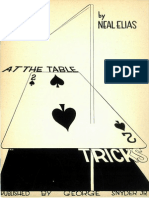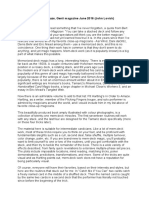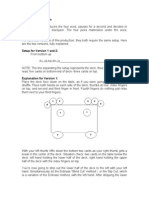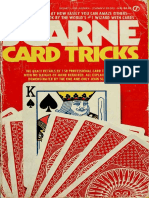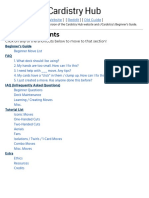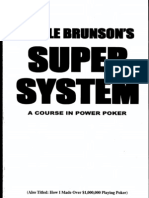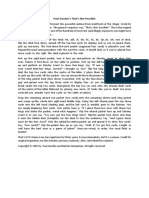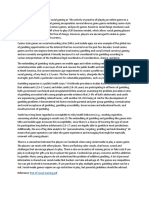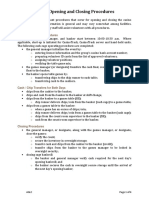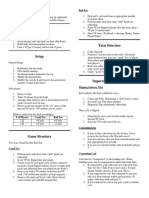Game Protection: Shuffle Tracking
Some of the biggest scams today, as well as some of the most effective advantage plays (legal
methods used by players to gain an advantage over the house, as opposed to cheating), require
memory skills that can be easily acquired with a bit of training, though practice is needed to be
proficient enough to use those skills effectively. A trained memory is a powerful weapon to those
who like to see a casino.
Shuffle tracking is when a player uses card counting to track where the good cards are in the
deck so that he can bet to his advantage. the relationship between memory and certain advantage
plays. For card counters (a type of advantage player or AP), a great memory is not necessary, as
they are only keeping track of one or two numbers at most: the running count and the true count.
A player looking to legitimately capitalize on a blackjack game using an advanced strategy
would need a stronger memory. For example, let us look at slug tracking and sequential tracking
or “excellent tracking,” as it is commonly known, both being forms of shuffle tracking.
Shuffle trackers can identify a clump of high-value cards during play, then follow that clump to
the discard rack and through the shuffle, so that they can exploit the information during the next
shoe. Knowing when that clump of high cards will be dealt, shuffle trackers can increase their
bets accordingly and gain a significant advantage over the house. This may sound simple, yet it
requires well-cultivated skills.
Slug Tracking is identifying a post shuffle slug that is rich in high (aces and 10-value cards) or
low cards. To shuffle track, players must be able to keep several different running counts in their
heads at the same time, then refer to those numbers at a later point, at which time they must add
to or subtract from those numbers. Each shuffle is “mapped” so that these players know which
segments of cards will be joined together through the shuffle procedure.
In ace tracking, another AP technique and more elaborate form of shuffle tracking, the dealer
legitimately shuffles the cards, and the AP can predict, with good accuracy, when an ace will
appear (based on information memorized from the previous shoe), giving them the opportunity to
bet big at that point with a substantial advantage over the house. In blackjack, when a player
knows that the first card of a hand dealt to them will be an ace, they have a 52 percent advantage
over the house. This is monstrous! 3
The player would memorize the three cards (suit and value) in sequence, called the key cards,
which will be on top of the targeted ace after the dealer picks the cards up and places them into
the discard rack. The ace (with suit) is also memorized, so that the order for this sequence would
be queen of hearts, four of spades, seven of clubs, and ace of spades, in that exact order.
False shuffles for crooked dealers, are skilled at sleight of hand and employed false shuffles after
their accomplices wrote down the order of the cards from the previous shoe. The accomplice
would then leave the table to calculate all outcomes of the slug recorded. After identifying key
cards during play, the scribe and confederates would know exactly when the slug would appear
and whether to bet player, banker, or tie (or even the many side bets now available) for multiple
hands to follow because they knew the exact order of the cards that were about to be dealt.
�One of the biggest baccarat scams ever (up until that time), swindling casinos across the U.S. and
Canada out of an estimated $7 million. They used a network of players and dealers, whom they
recruited and trained to do false shuffles (that annoying sleight of hand skill). A team member
would record a slug during one shoe by writing it on a baccarat score card. Then, the dealer
would employ some false shuffles, but not for the entire shuffle procedure, to retain the order of
the slug. Knowing the exact order of the cards, and thus the outcome of the hands involving
those cards, the team would capitalize on the information.
In response to this scam, some casinos have eliminated baccarat score cards and have installed
electronic scoreboards instead, which display the results of the hands of the current shoe. Many
legitimate baccarat players are superstitious, so they sometimes like to bet with a trend when
they see it. Electronic scoreboards are a great tool for them to quickly walk by a table and spot a
trend they would like to bet on or against (like banker shown to win many times throughout this
shoe), and subsequently, an ingenious marketing tool for the casino.
A dealer removes the cards from the shuffle machine, gives a player the cut card, then presents
the cards for the player to cut. Somewhere between offering the cards for the cut and placing the
cards into the shoe to deal, the dealer “accidentally” spills the cards onto the table with many of
the cards landing face up fanning the cards to the player informing the player of card locations in
the deck.
Memorizing the cards after the deck is cut in Baccarat can help the player to memorize the order
of the cards. During the shuffle, the dealer would riffle the cards too high. This enables him/her
to see the index, and thus the value, of the card at the top of the segment in the left hand. The
dealer memorizes the card and continues the shuffle procedure. On the next riffle, the dealer will
again riffle high to see that top card in his/her left hand, and using sleight of hand, deliberately
place the peeked card directly on top of the card on top of the pile in the right hand, which is the
first card peeked and memorized.
A trained memory is not just a device for those looking to take advantage of or swindle a casino
game. Memory can also aid casino staff in observing a play, whether it is during a review or
while watching it live, and to increase productivity. Those who can efficiently recall players’
names, account numbers, table and pit numbers, camera and zone numbers, buy-ins, wagers,
payouts, win/loss, etc., can get the job done more efficiently and accurately, and provide better
customer service to patrons than someone who must constantly refer to something else, like a
touchscreen or piece of paper for information, at which time they may also miss something
important that is happening on the game.











